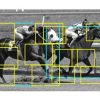Free Online Productivity Tools
i2Speak
i2Symbol
i2OCR
iTex2Img
iWeb2Print
iWeb2Shot
i2Type
iPdf2Split
iPdf2Merge
i2Bopomofo
i2Arabic
i2Style
i2Image
i2PDF
iLatex2Rtf
Sci2ools
CVPR
2008
IEEE
2008
IEEE
A discriminatively trained, multiscale, deformable part model
This paper describes a discriminatively trained, multiscale, deformable part model for object detection. Our system achieves a two-fold improvement in average precision over the best performance in the 2006 PASCAL person detection challenge. It also outperforms the best results in the 2007 challenge in ten out of twenty categories. The system relies heavily on deformable parts. While deformable part models have become quite popular, their value had not been demonstrated on difficult benchmarks such as the PASCAL challenge. Our system also relies heavily on new methods for discriminative training. We combine a margin-sensitive approach for data mining hard negative examples with a formalism we call latent SVM. A latent SVM, like a hidden CRF, leads to a non-convex training problem. However, a latent SVM is semi-convex and the training problem becomes convex once latent information is specified for the positive examples. We believe that our training methods will eventually make possible...
Computer Vision | CVPR 2008 | Deformable Parts | Latent Information | Latent Svm | Non-convex Training Problem | Person Detection Challenge |
| Added | 12 Oct 2009 |
| Updated | 28 Oct 2009 |
| Type | Conference |
| Year | 2008 |
| Where | CVPR |
| Authors | Pedro F. Felzenszwalb, David A. McAllester, Deva Ramanan |
Comments (0)

